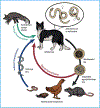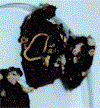Role of cats in human toxocarosis
- PMID: 35979067
- PMCID: PMC9380441
- DOI: 10.12968/coan.2020.0104
Role of cats in human toxocarosis
Abstract
Toxocara cati, the feline ascarid, is ubiquitous in domestic cats globally and is increasingly recognised as an important zoonotic species. In the definitive host, infections with the adult ascarid usually do not present any clinical signs; if clinical signs do appear, it is usually in kittens infected with T. cati, especially by the transmammary route. Diseases may include cachexia, a pot-bellied appearance, respiratory disorders, diarrhoea, vomiting, among other signs, and these may present as early as 3 weeks of age. However, infections with Toxocara spp. larvae in paratenic hosts (including humans and many other animals), can result in serious complications from the migration of larvae. Historically, there has been an assumption that Toxocara canis was the most likely cause of Toxocara spp.-related disease; while it is probably true that T. canis is responsible for the majority of infections, it is important that those caused by T. cati are accurately identified so that the contribution of this parasite to human disease can be established and then handled appropriately. Overall, the detection of infections in cats and the control of parasite stages in the environment are essential to minimise the infection risk to other animals or humans.
Keywords: Toxocara cati; control; human toxocarosis; prevention; zoonosis.
Conflict of interest statement
Conflicts of interest: none.
Figures




References
-
- Aoki S, Yamagami T, Saeki H, Washizu M. Perforated gastric ulcer caused by Toxocara cati in a cat. Nippon Juishikai Zasshi. 1990;43(3):207–210. 10.12935/jvma1951.43.207 - DOI
Grants and funding
LinkOut - more resources
Full Text Sources
Miscellaneous
